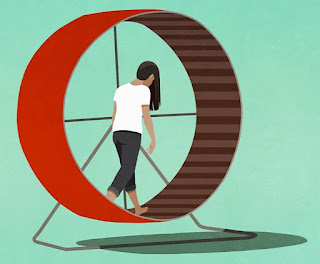Stuck in the Middle: What to Do When You Feel Numb, Not Depressed
Feeling emotionally flat or numb, even when life seems good? Discover the science behind languishing—why you're not depressed, but not thriving—and how to find joy again. Mental Health Awareness Week spotlight.
There’s a quiet, hard-to-explain emotional space where you’re not in crisis—but you’re definitely not okay. You're getting through the day. You're handling responsibilities. But inside, everything feels… flat.
You're not sad. You're not happy. You're just numb.
This is what mental health experts call languishing—and if you’ve been silently drifting through your days with low motivation, scattered focus, and zero spark, this one’s for you.
The Science of “Meh”: What Is Languishing?
First coined by sociologist and psychologist Corey Keyes, languishing is the in-between state of mental health. You’re not clinically depressed, but you’re not flourishing either. You feel "blah" for lack of a better word, but we all know the feeling.
It’s that *blah* feeling you can’t explain. Like your energy is muted and your enthusiasm is on pause. Like you are part of the environment, but separated from the feelings.
A 2021 article in The New York Times called it “the dominant emotion of the year”—but the truth is, languishing never really left.
Why You Might Feel Numb—Even When Life Looks Good
Let’s be clear: emotional flatness doesn't mean you're ungrateful or broken. In fact, your brain may just be stuck in survival mode.
Here’s what could be going on beneath the surface:
🧠 Under-stimulated reward system – Your brain’s pleasure center gets quieter when you're missing joy, purpose, or novelty.
📉 Low-grade chronic stress – Keeps your nervous system stuck in fight-or-flight mode, even if there's no visible crisis.
🤐 Emotional suppression – You may be avoiding deeper feelings because it’s easier than dealing with them.
🪞 Lack of meaningful connection – Being around people isn’t the same as feeling emotionally safe or seen.
🔄 Too much routine – Stability without passion leads to emotional autopilot.
How to Break the Cycle
Escaping the numbness isn’t about doing more. It’s about reconnecting—with yourself, your feelings, and your values.
✍️ 1. Call it what it is.
Naming your experience—languishing—gives your brain clarity. It tells your nervous system: "I see you."
🪄 2. Add intentional meaning to your day.
Instead of focusing on being productive, ask:
What would make me feel alive today?
A deep conversation
Watching the sunset
Making music or art
Even 5 minutes of meaning creates momentum.
🔁 3. Micro-dose joy.
Water your plants
Light a candle
Dance to one song
These tiny rituals help reactivate the brain’s reward pathways.
🧠 4. Process, don’t bypass.
Let yourself feel—even if it’s uncomfortable. Emotional honesty is the first step to healing. Journaling can be a safe space for this.
🎧 5. Change your sensory input.
Try a new podcast, playlist, or walk in a different neighborhood. Novelty resets the brain.
6. Let someone in.
Tell one person what you're feeling. A friend, a therapist, a support group. Connection breaks isolation’s grip.
You’re Allowed to Be Not Okay Even When Life Is Okay
The world may expect you to be grateful, high-functioning, and strong. But let’s get honest:
Strength is telling the truth.
Healing is giving yourself permission to feel.
And growth starts where numbness ends.
🧠 Tomorrow’s Post:
“The Cost of Pretending to Be Okay: Smiling Depression & Silent Suffering”
We’ll dive into how emotional pain hides behind high-achievers—and why masking struggle can be dangerous.
Mental Health Awareness Week is about more than big conversations—it’s about making space for the quiet truths. If you’ve been stuck in the gray, this is your invitation back to color.


Comments
Post a Comment